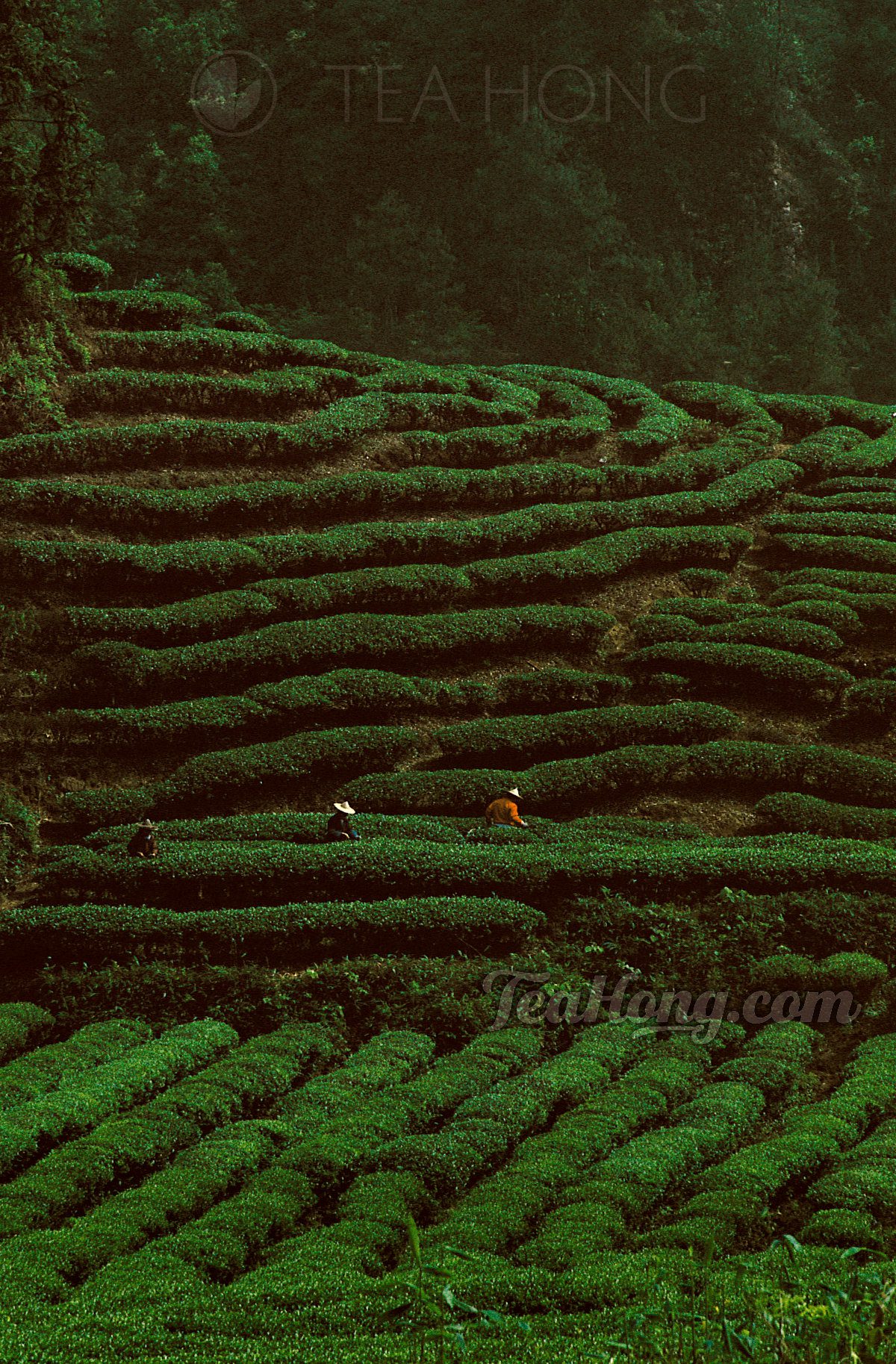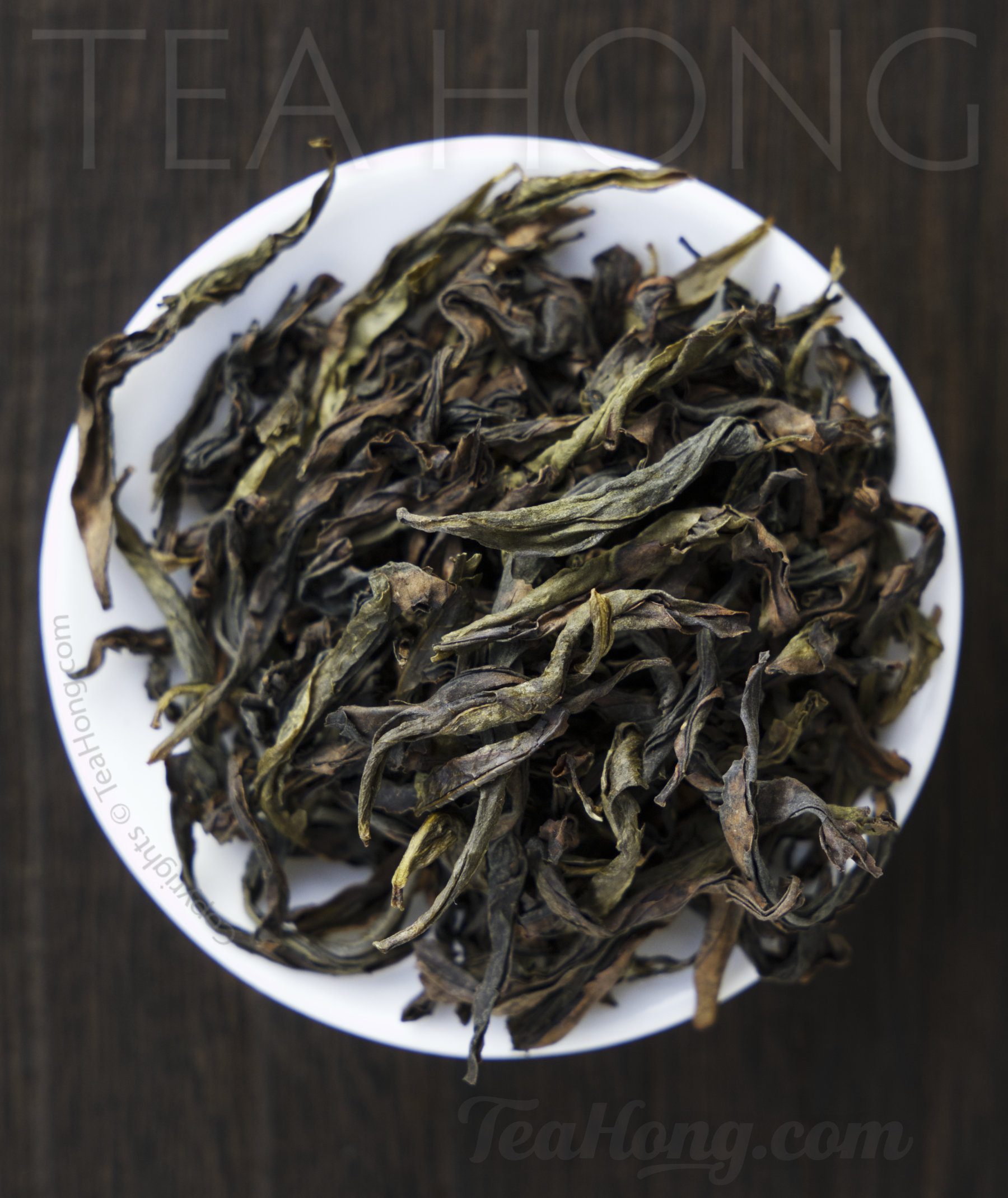

A production tea garden on a hilltop in Wuyi Shan, immediately next to a prestigious origin, Zhong Xin Yan. Tea fields in the latter is much smaller, with poorer trees yet the produce would be many times more expensive.
Problems with getting a good Wuyi oolong
Wuyi oolongs have always been problematic for fine tea merchants. It is one of the most sought after oolong subcategories, and yet with extremely irregular pricing and huge variation in quality. All products are delivered in strikingly similar look, all claiming from some prestigious origins — Ma Tau Yan, Tian Xin Yan, Niu Lan Kang…
For those who have been to real production farms ( as opposed to “showcase” farms ) in Wuyi know that there are plenty of better tea fields beyond the traditional big names, many in peaks adjacent to those over-farmed small patches of “origins”, while enjoying the same microclimate and a more fertile terra, and less of a hype. That means better quality at better prices. Without access to these, Tea Hong would have to sell at 40 times the price for the Narcissus Classic from Tian Xin Yan, or over 50 times the price for a Cassia Classic from Ma Tau Yan, like they do in China. Many even at more exorbitant charges.
After the issue of origin, there is that of the fire
After the claim of origin, there is the argument of whether a certain tea should be “Qing Xiang” or “Nong Xiang” — i.e. lightly baked or heavily baked.
Traditionally Wuyi oolongs are deep-baked for many reasons, which I will elaborate in another post, but the skill in how to aptly use fire on the tealeaves has not been passed down as a standard. It has become a lost art that only a few who are really passionate in making fine tea still practice.
Opportunistic profiteering does not make quality


A technician gangs up a few sieves of leaves into one and pile them up as a large donut for the last round of oxidation. Fan family tea factory, Wuyi Shan. It takes patience and know-how to properly produce a traditional fine Wuyi.
The vast majority of products are now either forced fired or under-baked. The patience and finesse in dealing with the change of the contents of the leaves in the few months after plucking and initial processing have been taken over by ignorance, arrogance and blatant cost saving for higher margin.
The myth and vanity that is so widespread in the nova riche in China for the first batch of tea from a historic origin keeps the drive for unreasonable pricing. It is not unusual to see a batch marking the equivalence of thousands of USD for 500g. Producers get hooked on to the rush to push their first harvests out to profit from this ostentation complex. Ignoring traditional practices for saving time becomes a norm, while sacrificing real quality. On and on, malpractice becomes the new tradition. It has been saddening to see it happen through the decades I have been in tea, incapable of turning the tide.
Proper baking requires patience
To properly and thoroughly bake a Wuyi oolong, a few rounds of passing into the oven, be it heated with electricity or charcoal ash, with a different temperature each time, and a monitored rest in between. The resting can be a few hours, a few days, or a few months, depending on the depth of the baking style, i.e. whether one wants it to be “Qing Xiang” or “Nong Xiang”. As for the change of temperature, the final style is also the deciding factor. It usually goes high to low in Qing Xiang style and high to low and then high again in Nong Xiang style. Most properly matured oolongs are baked a couple of years into maturation. Again, I am referring to the traditional way.
Lighter baked Wuyi
Indeed, traditionally Qing Xiang style did exist, only rarely for export so people outside of the production area rarely knew it. It used to be enjoyed by the locals. Aptly baked Qing Xiang style offers a bouquet that is obscured in classically baked versions. The same situation happened to oolongs of Anxi ( e.g. Tieguanyin, Huangjin Gui etc ) and those of Phoenix ( e.g. Eight Immortals, Song Cultivar etc ). The difference though, is that even the lightest baked Wuyi oolongs is much deeper baked than any lighter baked Phoenix or Tieguanyin. Their habitual use of higher temperature produces an overall more “baked” impression. Therefore, we have never called any Wuyi oolong as Qing Xiang, but instead use the term bouquet.
Understandably, when it took at least half a year to move to the tea to an export port, another few months or more on a boat through any range of climates, yet more months in half empty jars in retail shops, deeply baked ones does fare a little better than those less fired.
It is the proper technique that matters, whether deep baked or medium baked
However, with the advent of better packaging, storage and logistics, we can now enjoy both baking styles. Deeper understanding of the nature of tea and thus better quality control and handling help a great deal too.
Nevertheless, proper baking in either style is still essential for quality, especially when the the tea matures.
In the Wuyi oolong collection at Tea Hong, there are a few selections of Nong Xiang style, such as Red Cloak Grande and Narcissus Classic, and a few others with a range that are relatively lighter baked. The lightest one is the bouquety Cassia Extraordinaire.
Good for longterm


Man carrying two baskets of fresh tea leaves back to his home processing shack while the son following. Wuyishan, Fujian
Tea Hong Wuyi oolongs are baked for long term storage, no matter if it is deep or medium fired. Now not a lot of teashops can say that. Unlike popular practice, we do not push our products when we have got them, but properly rest/mature these twiggy leaves from the steep slopes in northwestern Fujian for enjoyment on delivery. Therefore, you will never see a current year harvest earlier than summer in our shop, although all are first flushes. Some of the teas are matured a few years before release.
Again, please do store the tea in a cool dry place, properly sealed and away from the sun. Use an opened pack within a month.
Comments (0)
Leave a reply
You must be logged in to post a comment.









